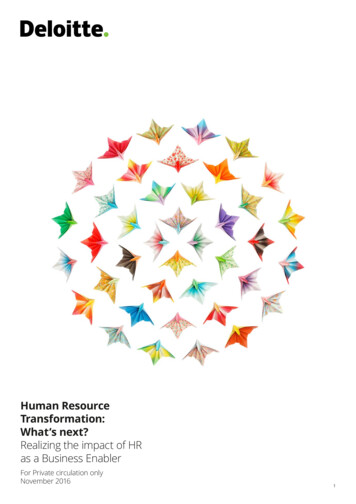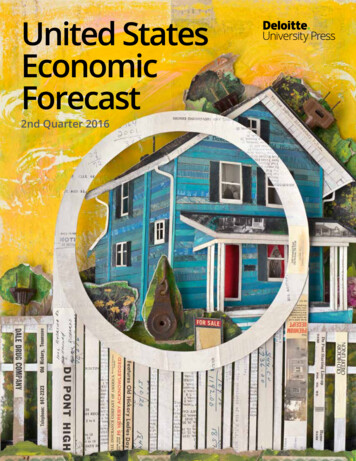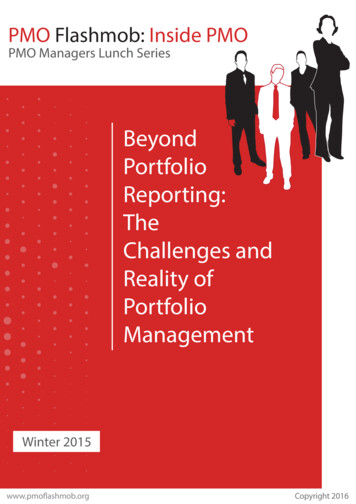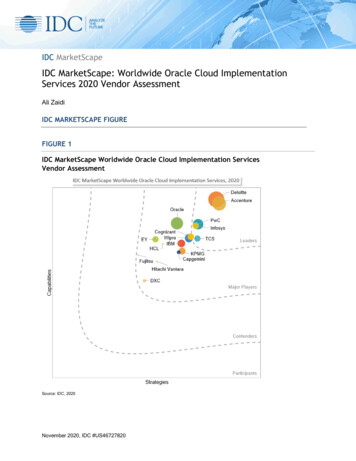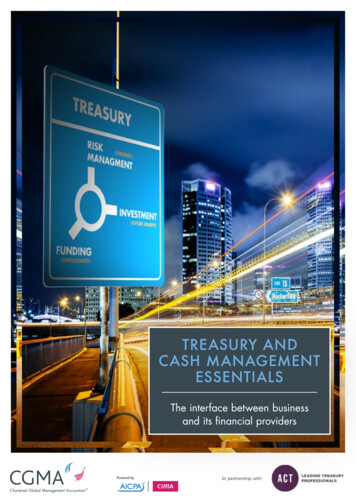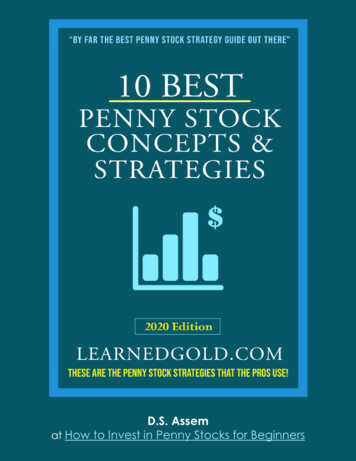
Transcription
Braving the wind of changeResilient portfolio strategy
Monitor Deloitte is Deloitte’s strategyconsulting team. We help leading globalorganizations to navigate the future withconfidence by making clear, timely, andinspirational strategic choices that delivergrowth in a dynamic, disrupted world. Weachieve this through a combination of deepindustry experience, cutting-edge capabilities, and an entrepreneurial mindset, whichallows us to collaborate with our clientsto resolve their most critical decisions,drive value, and achieve transformationalsuccess.The Center for the Long View (CLV) isDeloitte’s Competence Center for thedevelopment of innovative strategiesbased on the design of scenarios. We assistdecision-makers in developing robuststrategies for companies and organizations. Our portfolio includes innovativemethods, processes, and solutions for thedevelopment of strategic future scenariosand the corresponding courses of action–individually tailored to industries and thespecific situation of our clients. The futureis yours to manage!
Braving the wind of change Resilient portfolio strategyExecutive summary04The case for resilient portfolio strategy05Resilience as a key portfolio feature08A resilient portfolio survives scenarios10A resilient portfolio builds optionality10A resilient portfolio balances feasibility and risks11A case in point: Media Company X12Towards a resilient portfolio14Evaluation of industry trends and drivers18Development of scenarios and implications26Portfolio assessment36Strategy development and adjustment over time46Summary: Future-proof portfolio52Conclusion54Sources5703
Executivesummary In a world of increasing volatility and complexity, scenario thinking becomes vitalfor considering the different ways the future can play out To do so, executives need to think holistically about a company’s portfolioto sustain the aggregate value of holdings in the long run Two central questions to be answered: How does the current portfolio performin alternative scenarios? What are no-regret options for the portfolio? Monitor Deloitte has found that organizations need to build resilience within theirportfolios to appropriately address critical uncertainties in the future A resilient portfolio performs well across a range of plausible industry futuresand gives the company the flexibility to change strategic course The exercise is a crucial step towards building an advantaged portfolio that is notonly resilient but also strategically sound and value-generating For illustrative purposes, the twelve-step approach is exemplified through afictitious global media company responding to uncertainty“ The best strategies position a company towin not only today, but in the future. Howeverbecause we can't perfectly predict the future,scenarios are a critical component of anystrategy process. Scenarios do create animportant choice for executives, however–do I optimize my portfolio for a single futureoperating environment, or do I build inresilience to ensure my portfolio can surviveand thrive in a range of potential futures/scenarios.”04Gavin McTavishGlobal Offering Lead for Corporate andBusiness Unit Strategy and co-author ofBuilding an Advantaged Portfolio
Braving the wind of change Resilient portfolio strategyThe case for resilientportfolio strategyAssessing and designing corporate portfolios in anuncertain world requires a resilient approach tomanaging company portfolios.Where to get the best bang for your buck?This question is one of executives’ mostchallenging tasks, i.e. to allocate finitecapital resources across a wide range ofbusiness units, projects, and investmentoptions.Here pressure from capital markets to finda company’s optimal investment mix hasrecently risen to all-time highs. In particular,activist investors increasingly criticizeexecutives who are not maximizing thevalue of their respective firms and they aretightening the thumbscrews. Executivesare hence forced to constantly justifyexisting investment or business unit portfolio decisions as to whether they offer theoptimal return on investment.Today, the advent of new technologies,an intensified race to go digital, changingcustomer requirements, and macro-shiftsin the economy and/or culture createturbulent times for organizations andpose existential challenges to their valueproposition – not to mention the threat ofdisruption by innovative competitors frominside and outside the industry. Businessunits that today add substantial value toan organization may fail to contribute anyprofits in the next year due to changedcustomer requirements.Today’s large global companies are alreadyreacting to the new market environmentby investing in new fields of business andselling off existing business units:In 2018, the acquisition of the UK telecommunications company Sky resulted fromone of the most intense bidding wars. Itraised the final cost far beyond the initialbids offered by the two main bidders21st Century Fox and Comcast. Sky putsComcast in a better position to competeagainst emerging disruptors (e.g. Netflix)and their offers to its customers. Theacquisition will provide new content andservices for Comcast and thereby shift thecompany’s portfolio more towards medianetworks.no longer sufficient and new concepts areurgently required. Organizations need tolook beyond building portfolios that arestrategically sound in today’s prevailingmarket conditions and build long termresilience within their corporate portfoliosto appropriately address critical uncertainties in the future. A resilient portfolioperforms well across a range of plausibleindustry futures and gives the companythe flexibility to change its strategic coursedepending on how critical near-termevents unfold.In 2011, S&P Global (McGraw-Hill Companies before 2013) took a similarly impactfulportfolio decision. Divesting its educationbusiness, McGraw-Hill, and realigning itsoperating model to focus on core capabilities in financial information and analytics,S&P Global increased its market value byabout 23 billion. Although both decisionsconstitute considerable changes to thecorporate portfolio, their context is verydifferent:Of course, designing an (investment orbusiness unit) portfolio resiliently, comesat a certain price and companies have todecide if they want their portfolio to beresilient. However, from our perspective,resilient portfolios offer inherent value toorganizations, e.g. maximized return oninvestment and minimal external interference.Comcast’s acquisition of Sky is a reactionto a rapidly changing media environmentwith new competitors such as Amazon andNetflix. By contrast, McGraw-Hill Companies was a potpourri of distinct businessesand brands in the financial, media, andeducation industry without any sourceof short or medium-term synergies. Toremain successful in a highly volatile market environment, traditional (static) portfolio management approaches are, however,The goal of the study at hand is to providea dynamic approach towards strategicportfolio management that enablescompanies to establish a resilient portfolioand confront uncertainty, especially whenassessing and designing corporate portfolios. To make our approach more tangible,we will illustrate all aspects with the helpof a fictive media company.05
What is an Advantaged Portfolio?In our experience, successful–advantaged–portfolios exhibit three distinctcharacteristics that make them standout from the crowd: they are strategicallysound, value-creating, and resilient. Tobe successful in the long-term, portfoliosmust fulfill all three criteria. Assessingand fine-tuning these characteristicsshould hence be the objective of anycorporation aiming to build and maintainHoldingMediaCompany XSegmentHowever, portfolios also exist at a moregranular level–within a business unit, division or product line–and can besubject to portfolio analysis, whereby theproposed approach can also be applied.Fig. 1 – Organizational structure Media Company XTelevisionOfferingsMerchandisingand Theme t is a portfolio?In the context of this study, we refer to aportfolio as the collection of businessesthat an organization has invested in orowns. These businesses are strategicallydistinct, as each of them has its own setof competitors with only a few overlaps.Their competitors may differ regardingthe basis of competition (e.g., cost- ordifferentiation-based competition) or sChannelPay TVa top-performing portfolio. To do this,Monitor Deloitte has developed a multi- dimensional framework that tests eachof these characteristics across a rangeof criteria (see Figure 1). This enables theAdvantaged Portfolio framework to addressdrawbacks of traditional portfolio models byconsidering not only the individual portfoliocomponents, but also the interactionbetween them, enabling an evaluation ofthe system as a whole.Fig. 2 – Three characteristics constitute an Advantaged PortfolioStrategicallySoundCompetitively PositionedBalances InnovationCreates SynergiesValueCreatingMaximizes Intrinsic ValueAddresses Market ValueFinds the Right OwnerResilientSurvives ScenariosBuilds OptionalityWeighs Feasibility and RiskSource: Monitor Deloitte (2015): The Crux of Corporate Strategy–Building an Advantaged Portfolio06
Braving the wind of change Resilient portfolio strategy“ Markets are constantlyin a state of uncertaintyand flux and money ismade by discounting theobvious and betting onthe unexpected.”George Soros07
Resilience as a keyportfolio featurePortfolio resilience is vital for sustainable business successIn today’s business environment, executives, strategists and corporate portfoliomanagers operate in a field of tension.On the one hand, many business modelshave reached the plateau of their s-curve(i.e. growth curve over the life cycle) andshifted their focus towards efficiencygains. The increasing influence of capitalmarkets, especially activist investors,additionally forces companies to strive foroperational excellence by rigorously cuttingback on non-value adding expenses orefforts. This “pressure for efficiency”often reduces innovation capabilities ascompanies concentrate on moderatingexisting value streams. Investors urge corporate decision-makers towards prudencemaximizing the return on investment of anoptimized portfolio.On the other hand, companies increasingly feel a “pressure for innovation”to move to the next s-curve requiringdisruptive innovations and new value creation approaches. However, none of thedecision-makers knows which innovationbrings long-term success to their organiza-08tion. They are acting in a vacuum withouthaving a clear framework or guidance forthe future. Consequently, they are forcedto make several vague bets and experiments managing a “portfolio of bets”.The trade-off between the “pressure forinnovation” and “pressure for efficiency” isone of the key challenges executives, strategists and corporate portfolio managersface today. The resilient portfolio strategyoffers an attractive approach to solvingthis trade-off, combining innovation withefficiency or prudence.A resilient portfolio is based on three maincharacteristics: a resilient portfolio 1)survives scenarios, 2) builds optionalityand 3) balances feasibility and risks. In thefollowing, we explore these characteristicsas well as the methodological fundamentals.
Braving the wind of change Resilient portfolio strategyFig. 3 – Resilience as a key featureStrategicallySoundCompetitively PositionedBalances InnovationCreates SynergiesValueCreatingMaximizes Intrinsic ValueAddresses Market ValueFinds the Right OwnerResilientSurvives ScenariosBuilds OptionalityWeighs Feasibility and RiskSource: Monitor Deloitte (2015): The Crux of Corporate Strategy–Building an Advantaged Portfolio“ I can’t take the risk ofchoosing path A or pathB today. I need to knowwhether I can get the dealsdone before I commit oneway or the other ( ).”Electronic Materials Company CEO09
1) Resilient portfolios survive scenariosIn a world of constant flux, businesses facechanging customer preferences, the proliferation of emerging technologies, anda shifting geopolitical landscape, amongothers. Although some trends are easy topredict, others are unknown while havingoutcomes that could be highly impactful.A resilient portfolio will respond to variousbusiness environments.To frame future developments, scenarioplanning is the concept of choice. Itconsiders the non-linearity of trends,asking for extreme endpoints of futuredevelopments. By combining elementscoherently, it helps to depict convincingstories of market environments (scenarios).Executives can determine implications forindustry dynamics, both customer as wellas and stakeholder needs and draw portfolio conclusions for each scenario.2) Resilient portfolios build optionalityA resilient portfolio provides a companywith the necessary flexibility to masterevery occurring challenge and to identifyprofitable opportunities before theybecome a commodity. The anticipation ofmore than one potential future scenarioleaves portfolio managers with multipleoptions for value creation. Therefore,the development of options or “bets” is acrucial part of a resilient portfolio.The anticipatory nature of resilient portfolios enables executives and portfoliomanagers to gain flexibility to react (i.e.,invest or divest) to the most recent marketdevelopments quickly (i.e. efficiently). Theycan thereby respond to the “pressure forinnovation” as well as the “pressure forefficiency” in parallel.Resilient portfolio management helps toanswer the question of how the portfoliowill survive in different future scenariosand which strategy elements need to beaddressed to enable long-term success.It therefore responds to the “pressure forinnovation” by providing executives with alevel of "cognitive diversity".Fig. 4 – An “if/then” approach creates optionality (stage-gating)If event A occursPortfolio optionIf event B occursIf event C occursSource: Monitor Deloitte (2015): The Crux of Corporate Strategy–Building an Advantaged Portfolio10
Braving the wind of change Resilient portfolio strategy3) Resilient portfolios balancefeasibility and risksA resilient portfolio requires weighingfeasibility and risk.Feasibility considers the practical challengesof implementing a portfolio option. Forexample, feasibility dimensions includethe ability to finance, the availability ofM&A targets and the management’s abilityto execute.Risk addresses the potential for subsequent unfavorable developments. Thesedevelopments may include competitivereactions, the success or failure of newtechnology as well as changes to the regulatory environment.Each “bet or experiment” within the optionspace presents a different feasibility andrisk profile. Given an organization’s ambitionand risk tolerance, a resilient portfolio willappropriately balance risk and feasibilityagainst the upside potential. Feasibilityand risk must be assessed across severalorganization-specific dimensions andmeasured against the risk tolerance ofthe organization to result in the optimalrelation between risk and return.Fig. 5 – Exemplary framework to assess feasibilityand risks of different portfolio optionsSample DimensionsPortfolio Option XPortfolio Option YAbility to financeLowHighAvailability of targetsMedMedAntitrust barriersLowLowCompetitive ReactionLowLowTechnology RiskMedMedRegulatory RiskHighHighCapital markets reactionMedHighM&A integrationLowLowMacroeconomic RiskMedLowFeasibility (Pre-Build)Risk (Post-Build)Source: Monitor Deloitte (2015): The Crux of Corporate Strategy–Building an Advantaged PortfolioTo illustrate the methodology of Advantaged Portfolio and the new Resilient Portfolio Management approach, we will nowtake a close look at our illustrative MediaCompany X as a case study.11
A case in point:Media Company XTo illustrate the Resilient Portfolio Management approachand highlight the benefits, Media Company X will serve as acase study.Media Company X serves as an exampleof a company whose executives have successfully built and promoted a consistentlysuccessful portfolio of distinct businesses.Leveraging its core content-creationcapabilities, Media Company X not onlyeffectively combines several related businesses, but also manages to be present indiverse markets worldwide and reach itsloyal customers through many differentchannels, whether through movie tickets,advertising services in the B2B business,or exclusive content via pay-TV channels.Today, most of its businesses are amongthe leaders in their industry and createstrong synergies across the portfolio. Inthe past ten years, Media Company X’sshare price has increased significantly.Therefore, the company’s involvement insome of the most disruptive industriesmake it an interesting illustrative casefor investigating the Resilient PortfolioStrategy.The company’s portfolio consists of thefollowing segments: Television Offerings(with a variety of different topic-relatedchannels), Merchandising and Theme Park(focusing on merchandise, licensing as wellas theme parks and hotels), Media Production (a traditional content producer)as well as Streaming offerings (providingonline on-demand streaming services).12The Television Offerings business segmentcontains cable network business andbroadcasting that includes an Entertainment or Pay TV Channel. It makes up over40% of the company’s revenues, whichmostly depend on the number of viewersthat drive subscriptions and advertisingrevenues. While trying to diversify itsoffering through acquisitions, the FederalCommunications Commission (FCC)strictly regulates the top U.S. broadcasters, posing a limit on acquisition plans.The second business segment is theMerchandising and Theme Parks unit.Revenues stem from theme park admissions, hotel stays, sale of merchandiseand licensing characters and content fromfilms. To mitigate the challenges of intensecompetition and seasonality, Media Company X drives international expansion andgrowth by developing new products.The Media Production business unitcontains the production and acquisition oflive-action and animated motion pictures.To complement its studios, several largescale acquisitions have been made in thelast few years. These deals diversified thecompany’s portfolio and increased itsmarket power abroad, especially by addingnew content franchises to its offering,such as the filming of popular fantasybooks. Competitive pressure and shiftingpublic tastes are typical challenges thatare tackled by conducting key strategicacquisitions and thereby serving a broaderaudience with more diverse content.In its most recent reorganization, MediaCompany X created the new StreamingOfferings unit. It combines existing medialibrary offerings of the traditional TV channels with a new on-demand streamingservice. This enables Media Company Xto enter a sky-rocketing market. Here thecompany responds to rising user numbersof video-on-demand services and newcompetitors like Netflix entering a closerelationship with customers and takingover the value chain.
Braving the wind of change Resilient portfolio strategyFig. 6 – Derivation of Media Company X portfolio from industry alGlobalGlobalGlobalGlobalTV NetworkYesYesYesYesYesMerchand.YesYesNoNoYesMedia kyMTVESPNUNIVERSALCOMEDY CENTRALCBSHBOabcNBCParamount PicturesSHOWTIMEWarner Bros.Revenue(in EUR bn)FTEFootprintBus. nOfferingsMerchandisingand Theme iaCompany Sources: Annual Reports, Monitor Deloitte Analysis13
Towards a resilientportfolioThe Resilient Portfolio Management approach involvestwelve consecutive stepsAlthough the characteristics of a resilientportfolio are easy to understand, buildinga resilient portfolio in the light of uncertaintyis a complex endeavor. It is not simplya matter of assessing a few KPIs, butrather requires foresight, creativity, andoptimization. To enable executives to holdchallenging discussions about what to do(and what not to do), we have outlined ageneric framework for resilient portfoliomanagement and tested it against theMedia Company X portfolio.Building a resilient portfolio consists offour stages: 1) evaluation of industrytrends and drivers, 2) development ofscenarios and implications, 3) portfolioassessment, and 4) strategy developmentand adjustment over time. A company mayneed to adapt its approach to consider thespecific characteristics or environment14it operates in, while the emphasis ofindividual stages will vary by company.The four individual stages as noted in figure 07 each consist of four “default” stepsthat will be applicable in a wide range ofportfolio contexts.The presented approach is the outcome ofa series of workshops involving scenariodesign experts from the Center for theLong View as well as portfolio strategythought leaders within Monitor Deloitte.
Braving the wind of change Resilient portfolio strategy15
Fig. 7 – Outline of the resilient portfolio strategy approachDevelopment of scenariosand implicationsEvaluation of industrytrends and drivers1) Focal question4) Scenario frameworkWhat will the TV andvideo landscape looklike by 2030?ACriticalUncertainty 2DCriticalUncertainty 1CBDetermine the project scopeand strategic directionCombine critical uncertaintiesinto a scenario frame2) Driving forces5) Scenario narratives345CriticalUncertainty 2126CriticalUncertainty 1Identify drivers that have thepotential to impact the futureDefine framework conditionsfor each scenario3) Critical uncertainties6) Scenario implicationsHighGroupZone ofInterest12CategoryLow12LowPrioritize and cluster driversinto critical uncertainties16High3Determine resulting implicationsand strategic responses3
Braving the wind of change Resilient portfolio strategyPortfolio assessmentStrategy developmentand adjustment over time10) Strategic options7) Portfolio vulnerabilityScenariosAllBusiness unit 1Business unit 2NoregretReal optionBig bet1LowRiskHighDerive strategic options, rangingfrom big bets to no-regret moves8) Competitive positioning matrix11) Future-proof portfolioAbility to winDetermine dependence of businessunits on critical uncertaintiesIndustry attractivenessAssess industry attractiveness and abilityto win as ROI proxy in each scenarioDetermine resulting implications andstrategic responses for portfolio9) Strategic interplay analysis12) Sensing & monitoringBusinessunit 1Businessunit 2Businessunit 4Businessunit 3For each scenario, test the spillovereffects of the business unitsDefine indicators to monitortrend developments17
Evaluation of industrytrends and driversUnderlying factors of market changeshave to be analyzed in detail.18
Braving the wind of change Resilient portfolio strategy1) Focal questionThe resilient portfolio approach startswith formulating a focal question determining the strategic direction. For somebusinesses, the focus may be their respectivesub-sector and geography. In the contextof a corporate portfolio, the focus may lieon the common denominator that linksdistinct units. Ultimately, the focal questionneeds to serve as a guiding principle onhow to understand the dynamics shapingthe future.2) Driving forcesDisruptive forces can cause dramaticupheavals up until 2030. Drawing ontraditional and A.I.-based research, expertinterviews and extensive experience working with global TV and media companies,we have identified and analyzed the mostimpactful trends and driving forces thathave arisen and will most likely continueto affect the TV and media landscapethat Media Company X operates in. Thesetrends can be divided into five categories:In the present case, we focused on thequestion, “What will the TV and videoentertainment landscape look like by2030?”, which addresses the core of MediaCompany X’s operations. Social changes impacting the characteristics of consumer and consumptionpatterns Technological advancements Economic forces causing industry andmarket shifts Environmental forces Political dynamics and regulatorychangesPlease see page 20 for an illustrative overview of recent key trends in the industry.Fig. 8 – Evaluation of industry trends and driversWhat will the TV andvideo landscape looklike by 2030?Determine the project scopeand strategic direction3) Critical uncertainties123High2) Driving forces456Identify drivers that have thepotential to impact the futureLow1) Focal questionZone ofInterestLowHighPrioritize and cluster driversinto critical uncertainties19
Fig. 9 – Recent (newspaper) headlines covering key trendsFacebook Announces NewWays to Watch Live StreamContent on Your Home TVApple Readies 1 BillionWar Chest forHollywood ProgrammingSocial Media TodayWall Street JournalAn AI Watched 600 Hours of TVand Started to AccuratelyPredict What Happens NextFuturismMobile Soon to PassTV in Time SpentNY TimesTV advertising is alreadydeclining. Here's whythings could get worse.Business InsiderHere’s why Netflix hasno interest in live TVRecodeSweden's Notorious Distinctionas a Haven for Online PiratesNY TimesDigital Media:Rise of On-Demand ContentDeloitteDiscovery buys PlaySports Groupto bolster new cyclingOTT service.Is the end of Netflix'sgolden age in sight?The GuardianSportsPro MediaNetflix is producing orprocuring 700 new or exclusivelylicensed television showsEconomistAmazon Is PlanningLive TV Recorder,Challenging TiVoBloomberg20
Braving the wind of change Resilient portfolio strategySpotlight on selected driving forcesPiracy: Anti-piracy services marketapproaches USD 1 bn worldwide in 2018.Increasing service adoption bundled withpremium content protection technologystacks is expected to reduce losses.However, revenue lost by global online TVand video services (excluding film entertainment) will amount to more than USD37 bn in 2018.Average time spent with TV and media:While the overall time with media hasbeen increasing steadily during recentyears, peaking at more than 7 hours a day,the time spent watching TV is expectedto decrease as consumers shift towardsdigital media consumption.Price of technological devices: Mobiledevices have seen decreasing averageprices. However, the proliferation ofsmartphones with bigger and edge-toedge displays has caused consumers tobuy products that are on average 20%more expensive than 2015–including theApple iPhone X as one of the most expensive smartphones available.Global media market consolidation:In 1983, 50 corporations controlled themajority of news media in the USA. Sincethen, although new media formats haveemerged, M&A activities have decreasedthe number of companies. Only five hugecorporations now control most of themedia industry in the U.S.21
What is uncertainty?In scenario development, uncertaintyrefers to the divergence of opinionsregarding a driving factor’s future outcome.Example: While some experts believethat awareness of sustainability and healthissues will induce greater self-directionof end-consumers, others are convincedthat convenience will drive delegation ofproduct selection to service providers.These divergent forecasts have resulted ina high level of uncertainty as they have thepotential to tip the future in one directionor the other.3) Critical uncertaintiesTo make sense of the identified drivingforces, we asked experts to assess theimpact of each driving force on the focalquestion as well as to predict their futuredevelopment path. Mapping the answersof these questions–with the degree ofuncertainty on one axis and the degree ofimpact on the other–yields a starting pointfor further analyses.There is some level of consensus on howsome highly impactful trends will evolveuntil 2030. As they exhibit a low level ofuncertainty, they are in the upper left quadrant of the matrix. Regardless of how othertrends will evolve, these elements can beconsidered predetermined and need tobe prepared for in any case. We can thusdevelop a base case for 2030–a picture ofwhat the TV & media landscape will probably look like in 2030.To prepare for trends being highly uncertain but highly impactful (upper right quadrant, “Zone of interest”), we will develop arange of scenarios.Exploring the unknownrequires tolerating uncertainty.Brian Greene22
Braving the wind of change Resilient portfolio strategyHighFig. 10 – Impact-Uncertainty Matrix and Zone of InterestRelative importanceof linear broadcasting in contrastto non-linear/ on-demand servicesRole of OTTsQualityof digitalinfrastructureRegulationof mediacompanyownershipMediumDegree of ImpactDigitalizationof video/ TVproductionprocessesNationalcontentquotasDegree ofinterdependencebetweensocial mediaand TVTVadvertisingmeasurementAbility of AI toinfluenceaudienceSize ofsupplierecosystemsAdvertisingpaymentDependenceof localproductionson subsidiesAbility of AItools topredict pingCorporatesocialresponsibilityExistenceof theEuropeanUnionRelevanceof n ee of UncertaintyLowTechnologyDevelopmentof cordcuttersSocietyEnvironmentPoliticsImportanceof sport/eventlicensingOwnership ofsports rightsZone of gdata privacyPiracyDiversificationof playersin the TV/ videomarketAveragetimespent withTV/ videoNumber ofcontentproducersDigitalcapability ofgeneralpublicAttractivenessof nationalvideo sectorfor talentsMobilerelevancyDemand for socialcontent/ user-generatedcontentEducationon media/video usein schoolsFocus ofpay-TVTransmission/FrequencyTV asenablerfor socialinteractionMultiChannelNetworksFocusof userengagementPolitica
A resilient portfolio balances feasibility and risks 11 A case in point: Media Company X 12 Towards a resilient portfolio 14 Evaluation of industry trends and drivers 18 Development of scenarios and implications 26 Portfolio assessment 36 Strategy development and adjustment over time 46 Summary: Future-proof portfolio 52 Conclusion54

